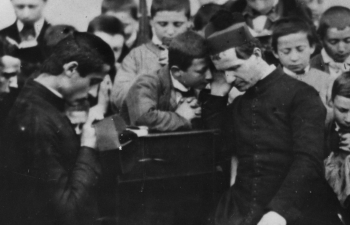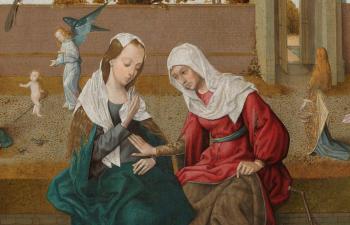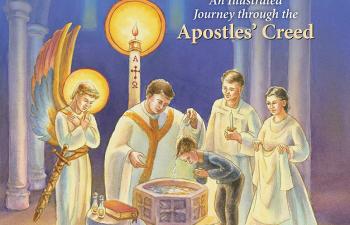 How is the family a way to holiness? What does the Church mean when she calls the family the domestic church? A brief summary of the Scriptures and the development in how the term has been used will prove helpful.
How is the family a way to holiness? What does the Church mean when she calls the family the domestic church? A brief summary of the Scriptures and the development in how the term has been used will prove helpful.
Judaism has always placed significance on the family. Family is everything for Israel. Without it, there is no covenant, and this is very clear in the Old Testament. But there is a tension within the New Testament. In the Gospels, Jesus seems to be critical of the family. In his call to discipleship, Jesus says, “If any one comes to me without hating his father and mother, wife and children, brothers and sisters, and even his own life, he cannot be my disciple” (Lk 14:26). Instead of uniting the family, Jesus seems to be the cause of its division: “For I have come to set a man ‘against his father, a daughter against her mother, and a daughter-in-law against her mother-in-law; and one’s enemies will be those of his household’” (Mt 10:35-36). For many Jews, Jesus’ threat to the family can be taken as a threat to the covenant itself. However, as Jesus says about his relation to the Law, he does not intend to abolish but to fulfill. Does that include the family?
“Domestic church” as a term to describe the Christian family has become a household phrase in recent years. Despite its use by the Church Fathers, the term fell out of use for more than a millennium. After Vatican II, it has become more common, securing a place in the Catechism of the Catholic Church, which states: “The Christian family constitutes a specific revelation and realization of ecclesial communion, and for this reason it can and should be called a domestic church” (2204), with a further development under the Sacrament of Matrimony in paragraphs 1655-1658.
Dr. Joseph C. Atkinson’s Biblical and Theological Foundations of the Family: The Domestic Church is, to my mind, the best in-depth study of the domestic church. It explores the purpose of the family in salvation history, starting with the Old Testament to its post-Vatican II development.
The Old Testament
The family’s role in Israel is so important that it is barely noticed; it is seldom even commentated upon by Jewish scholars. In a Mars Hill Audio interview, Dr. Atkinson relates that when he was doing his doctoral work on the family and its function in the Old Testament, he discovered that there is very little written on the theological significance of the family in Judaism. He later asked a rabbi why this was so, and the rabbi answered, “Well, it [the family] is like air. You’re surrounded by air. You drink it in. It’s absolutely everything. You could not live without it.”[1]
The family as domestic church is grounded in Hebraic anthropology that understands the human person in corporate terms. This notion is rife throughout the Old Testament. In the interview, Atkinson clarified the concept with an African proverb: “I am because we are.” Such an idea contrasts with the modern West’s understanding of the human person as “isolated, autonomous, self-determining individuals.”[2] The Church’s understanding of the Christian family as the domestic church presupposes such a corporate anthropology found throughout the Old Testament, and this needs to be clearly articulated to understand why much contemporary thought on the family, presupposing individualist anthropology, cannot be accepted by Christians.
In Genesis, the family is the fruit of marriage and is its purpose: “God blessed them, and God said to them, ‘Be fruitful and multiply’” (Gn 1:28). Marriage’s fecundity replicates the image of God throughout the world, helping to realize God’s intention of drawing humanity into full communion with himself through covenants, primarily the covenant with Abraham. It is crucial to note that these covenants and their promises are made with individuals and their families. Covenants are familial. Abraham and his family have been chosen and elected to re-Edenize the world. This is the purpose of Israel. For this reason, the human genealogies (tol’dot) in the Old Testament are important because they help realize that trajectory, which culminates in Jesus. He fulfills Israel’s purpose of bringing all the nations into communion with God by bringing them into communion with himself. But does the importance of the family as a tangible carrier of the covenant come to an end with the coming of the Messiah and the new family of the Church, or is it fulfilled by Christ?
The New Testament
The focus on Christ is not a threat to the family but its elevation. Through the Incarnation and Paschal Mystery, Jesus enters the human family and brings it into the divine family, establishing the Church, which calls humanity, Gentile and Jew, out of alienation from God and into communion with him.[3] This is a call of the covenantal family into its full realization in the Church.
Through the Sacrament of Baptism, which grafts us onto Christ, the family is immersed in Trinitarian communion. Like the Church, the Christian family is a new creation sent to communicate the life of God to the world. We can, in a way, view the domestic church of the Christian family as an icon of the Trinity.
In his Epistles, St. Paul speaks of the churches that meet in homes (cf. 1 Cor 16:19; Rom 16:5; Col 4:15). By being baptized in Christ, in the Spirit, the divine life informs the home, which means the household takes on an ecclesial dimension. Baptism replaced circumcision as the form of initiation in the People of God, and very often Baptism took place within the household. Just like in the old covenant, whole families entered into the new covenant and not merely individuals. Thus, the family did not pass away in the new covenant but found its eschatological perfection in Christ. Jesus’ rebuke of the family is not against the family per se but against the family as an idol that prevents a person’s conversion to him.
The Church Fathers
The phrase “domestic church” or its equivalent was used by many Church Fathers, especially St. Augustine of Hippo. He preached that fathers of families, like bishops and clergy, have an ecclesial role, being responsible for the care of the souls under them.[4] St. John Chrysostom does not use the term “domestic church” but calls the home a “little church.” In a commentary on Genesis, he encourages parents to “make your home a church in order to put the devil to flight” and to work towards the conformation of the family to Christ. Unlike Augustine, who thought that the domestic church flows from Baptism, Chrysostom stresses the effort parents need to take to turn their homes into little churches.[5]
The practical recommendations the Church Fathers offered on how to make the home a little church are still pertinent today, especially their insistence on reading Scripture as a family. One might think that their view of authority would be overly paternalistic, influenced by the Roman household. However, it is thoroughly Christian, based in the sacrificial love of Christ. In their view, married parents are icons of the mysterious love of Christ and his Church, and their children partake in this love. But understanding the family as a little church called to holiness fell by the wayside after Constantine with consecrated religious life becoming the primary model for holiness. It was not until the Second Vatican Council (1962-1965) that the idea of the Christian family as a domestic church was recovered.
Vatican II
Thanks to theological movements prior to the Council, many practices and notions prevalent in the Early Church were rediscovered, including the domestic church. Lumen Gentium, the Constitution on the Church, stressed the universal call to holiness for all states of life. Realities that seemed to be of a merely natural order were understood as being transfigured by Christ, taking on an eschatological fullness. This included the family as a domestic church. Lumen Gentium 11 sees the domestic church as an outgrowth of the Sacrament of Matrimony:
The family is, so to speak, the domestic church. In it parents should, by their word and example, be the first preachers of the faith to their children; they should encourage them in the vocation which is proper to each of them, fostering with special care vocation to a sacred state.[vi]
Lumen Gentium’s brief mention of the domestic church was then developed. Paul VI and John Paul I used the term, but John Paul II developed it the most in a “theology of the domestic church.”[vii] In his apostolic exhortation Familiaris Consortio, John Paul II develops the ecclesiality of the family, telling families to “become what you are” (17). As Augustine understood it, the baptized family is already a domestic church; but, as Chrysostom understood well, the family needs to actively become that reality. Pope Benedict XVI continued this legacy, and Pope Francis frequently uses the term, most famously in his apostolic exhortation Amoris Laetitia. The exhortation beautifully praises the Christian family as a way to holiness, ending with a prayer to the Holy Family.
In today’s world full of broken families, the invocation of the Holy Family to help all Christian families realize their mission to show forth Christ to the world is needed more than ever. And so is the full recovery of the vision of the family as a domestic church.
Robert Mixa is the Education Fellow of the Word on Fire Institute.
Notes
[1] Joseph Atkinson, Interview, Mars Hill Audio Journal vol. 130, https://marshillaudio.org/catalog/volume-130, minute 8:53.
[2] Ibid., minute 12:47.
[3] Joseph C. Atkinson, Biblical and Theological Foundations of the Family (Washington: CUA Press, 2014), 194.
[4] Augustine, De bono viduitatis [PL 40.450]); Ep. 188,3 [PL 33.849].
[5] Ibid., 269-289.
[vi] Emphasis added.
[vii] Atkinson, Biblical and Theological Foundations, 315.
This article originally appeared on pages 6-7 of the printed edition. Photo by Jake Ryan from Pexels (modified).
This article is from The Catechetical Review (Online Edition ISSN 2379-6324) and may be copied for catechetical purposes only. It may not be reprinted in another published work without the permission of The Catechetical Review by contacting [email protected]


















